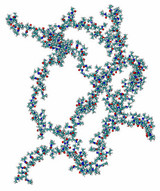Results
|
Within the Project A.4, the influences of the following factors on the swelling of hydrogels have been examined: Temperature, length of the polymer chains, degree of cross-linking, solvent, force field, and salt concentration. As an indicator for the degree of swelling, the radius of gyration over the simulation time is computed. For molecular dynamic simulations, mainly the polymer and hydrogel Poly(n-isopropylacrylamide) (PNiPAM) is used. PNiPAM polymers and hydrogels are experimentally well measured and show a strong temperature dependence of the degree of swelling.
For the simulations of PNiPAM, different protein force fields from literature were tested with the water models SPC/E and TIP4P. In particular, the force field combinations OPLS-AA with SPC/E and Gromos-96 53a6 (G53a6) showed good results. It is possible to simulate the temperature-dependent transition of the polymer conformation with both force field combinations.
From the comparison between different chain lengths of the polymers as well as star polymers and hydrogels, both, in simulation and in experiments it can be seen that the point of state, at which a hydrogel does swell is not dependent on the degree of cross-linking. Thus at which the hydrogel swells only depends on the polymer and on the solvent. Thus, it is possible to predict the behavior of the hydrogel by only simulating a suitably long polymer chain in solvent.


